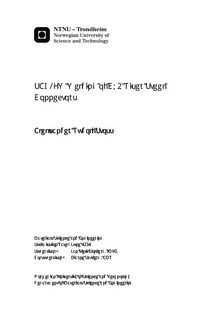| dc.description.abstract | Weld simulations have been conducted on a C90 quenched tempered steel used in offshore riser systems, in order to investigate the possibility of introducing an effective solid state weld procedure. As a secondary objective, the microstructure of the HAZ of a TIG welding is to be evaluated. The C90 is as steel of high hardenability and its base microstructure consists of tempered martensite with a Vickers hardness of 239 HV10. The main focus in this work has been to sufficiently soften the weld as well as obtaining impact toughness properties within requirements, by implying a post weld heat treatment procedure. Hardness values cannot exceed 270 HV10 and impact toughness energy must exhibit an average value above 40 J. Steel samples have been heated to a peak temperature of 1150 ˚C, followed by controlled cooling at 10 and 60 ˚C/s, prior to post weld heat treatment. Tempering at temperatures of 680 and 720 ˚C has been conducted on the post quenched structure for up to three hours and has been performed in an air circulating furnace and in a Smitweld Thermal Cycle apparatus. Low tempering times (up to 1200 s) have been performed in the Smitweld apparatus. Weld hardness and impact toughness requirements was met after three hours of post weld heat treatment at 720 ˚C in an air circulating furnace, producing a hardness value of 253 HV10 and a Charpy-V energy of 66 J for the parallel quenched at 10 ˚C/s. After some tempering of the structure, the two cooling rates used did not affect hardness values significantly. Tempering at 680 ˚C did not soften the structure sufficiently to meet the criteria, with the lowest measured hardness of 315 HV10 after three hours. The hardness of the intercrictial zone of the weld was reduced to 246 HV10 after tempering for three hours at 720 ˚C. Tempering in the Smitweld apparatus softened the structure more efficiently than what was observed in the furnace, producing hardness values of 271 HV10 after only twenty minutes of tempering at 720 ˚C. It has been suggested that due to substantially higher heating rates obtained by the Smitweld apparatus, low temperature tempering mechanisms may be inhibited or delayed, resulting in a post tempered structure consisting of coarse carbides with large inter particle spacing, contributing little to precipitation hardening. Heating rates obtained by Smitweld is in the same range as those obtainable by the SAG-FW procedure, and the two methods are therefore considered comparable. FMC Technologies uses a TIG weld procedure followed by a six hour post weld heat treatment to obtain satisfactory mechanical properties on the C90 steel quality. It is suggested, that by applying a solid state weld procedure, the total tempering time can be reduced with at least 50 %. | |

